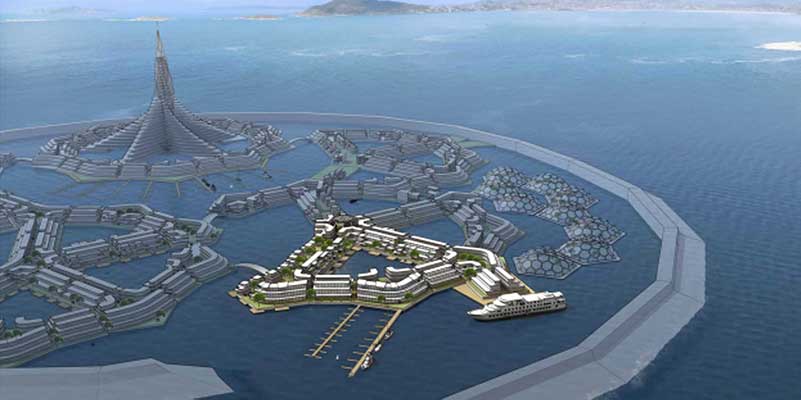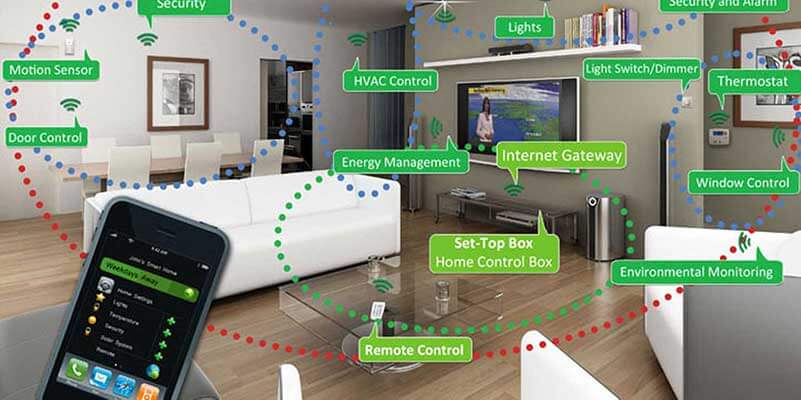Real estate has always been a bullish business. To many, it even seems as the least risky business of all. The value of land and homes never seems to touch the downside. Over the past century, we have seen how real estate has transformed from just houses and apartments to corporate parks, green societies, entertainment multiplexes, and shopping malls. Today, it is a booming USD117 billion industry with an average growth rate of 3.8% over the past five years. Therefore, it is necessary to look into the finer details and find out what will drive real estate in the future.
Speculating factors that will shape up the future of real estate is a precise matter. One has to look across the global real estate sectors, and the sheer variance amongst them makes the job a lot tougher than it sounds. While developed countries are looking for alternate opportunities, developing countries are still striving to perfect the available resources. However, some patterns and events do emerge and point toward a future where the correlation of real estate and its surrounding variables is more intertwined. Today, we will have a look at a few similar predictions. From data analytics to revolutionary 3D printing, every bit of modern technology is redefining real estate. We may also be looking at floating homes in the time to come! Let’s have a look at six predictions about the future of real estate.
1. How accurate will be the data provided by real estate portals and housing apps? Will we compromise on absolute accuracy?
Real estate of tomorrow might see agents being replaced by apps and price speculation being replaced by speedier and less accurate data-driven technologies. Thanks to the Internet of Things, speed is of great interest to consumers nowadays. People want information faster. Does that mean they are ready to compromise on accuracy? A seller making a pricing decision today needs different kind of data sets than a seller looking to sell in the future, and in real estate, that future can come very soon (even in a month). Let’s say a buyer is looking for a place in the current market due to a job change. If he needs a general feel of the pricing, his first step would be to check local listings on a web platform where both short-term and long-term prices are mentioned without precise annotations. Confusion might arise, don’t you think? Today, we can ship millions of bytes of data across the internet almost instantly and this has led to increased popularity of multiple listing services.
However, what agencies and buyers fail to realize is that the historical data may be flawed when one is searching for pin-point analysis and opinion. Today, powerful and affordable analytics tools can supply real estate firms with the power to provide valuable insights into the movements of the marketplace. However, if the data-sets involved are wrong and inaccurate or motivated by hidden profiteering agendas, then the results will be ultimately non-profitable. The problem which needs to be fixed from the core is data accuracy, and I believe it will need concerted efforts by portals, agents, and the public alike, which currently is very difficult to obtain.
2. Need a home? Well, why not print it using giant 3D printers!
Yes, people are actually working on 3D printing of homes. At Suzhou, a China-based company called WinSun (Yingchuang, to be politically correct) is experimenting with building homes using large 3D printers and a special ink made out of construction waste. This ink comprises high-quality stone, cement and fiber. Coupled with digital designs, it can print walls, bricks, and insulation, and the results seem to be spectacular. According to 3ders.com, a leading website dedicated to 3D printing, ten 3D printed homes arrived in Shanghai in March 2014. Remarkably, these 200-square-meter homes cost a total of USD6,000. How brilliant is that? One could imagine the world’s homeless been taken care for with almost no burden on the global economy. WinSun is well on its way to revolutionize global real estate for good. It is consistently innovating and growing by increasing construction speeds, decreasing costs, and lowering carbon emissions and wastes, all at the same time. Quite ideal, isn’t it? The company claims that it can save as much as 60% of material costs and 80% of labour costs, and reduce construction time by up to 70%. I see a future market leader in the making here.
Video credits: BI Tech
If you have doubts regarding compliance of these 3D printed structures, then let me tell you that China Construction Engineering Bureau finds them completely compliant with national standards. There are challenges though. As the technology is quite new, it is hard to determine its global feasibility at the moment. One cannot currently ascertain whether the safety of these buildings sync with typical constructions as building code varies significantly from region to region. Nevertheless, WinSun is expanding. It recently constructed a 1100-square-meter villa for a Taiwanese-owned real estate company that cost only 200,000 Canadian dollars. As its popularity is rising, so is its demand around the world. Recently, the Egyptian Government ordered 20,000 houses to be built. Collaborations with an American firm are also in full swing, with an aim to bring affordable housing to low-income families in Africa and the Middle East. I see this kind of technology as the benchmark for real estate in the future. Construction waste is literally the building block here. We are talking about sustainable growth, cost-effective and efficient procedures, and a safer environment. If that is not right, I don’t know what is. What do you say?
3. If you are a part of the ASEAN countries, you might as well get a chance to reside in floating cities!
If you have read Gulliver’s Travels, you will get a bit of an idea of what I mean. However, the difference is that cities here will float on water instead of levitating in mid-air like the island of Laputa from the book. Nevertheless, the concept is remarkable and highly advanced. The rapid economic growth and geographical location of ASEAN nations such as Thailand and Indonesia makes them ideal candidates for experimentation on this seemingly impossible concept. With many Asian coastal cities facing the risk of sinking from rising sea levels, such an initiative is long overdue. The Seasteading Institute predicts that such communities will start to emerge by 2020. The institute (funded partly by PayPal founder Peter Thiel) describes its agenda as trying to create a Silicon Valley of the Sea where experimentation in governance could be attempted with minimum risk and maximum benefit. The location of the first city is still undisclosed but the site has been surveyed and agreements have been drawn to be presented to the host nation. This is a very niche concept to take real estate in the future to a whole new level. For instance, there have been calls to solve Singapore’s land supply problems by creating very large floating structures (VLFS) and the whole scenario has been coined as Floating Real Estate.
These kinds of proposed projects can take a cue from existing ocean societies. For instance, the Tanka people from a Fujian province and Kampung Ayer in Brunei (which houses 20000 people) are great examples of oceanic societies. The problem regarding safety measures can be solved by looking into large off-shore projects through leading drilling corporations. Shell’s Prelude Floating Natural Gas Facility, off the North West coast of Australia, is designed to resist category five typhoons. Another example is the MegaFloat Project in Japan which was used to validate the long-term validity of such floating structures. As the above examples indicate, the existence of floating cities is a real possibility in the future. After all, we not only have the resources but also the skills and technology to carry such extraordinary experiments successfully.
See also: The healthcare industry – 6 techniques that will disrupt it
4. Corporate real estate will rely heavily on big data and the Internet of Things
In our previous posts, we have seen how the Internet of Things and big data are already impacting major business sectors. Corporate real estate is no different. Data at its core value is the key to speculating all the variables when it comes to real estate.
From fluctuating market prices to global variations and listing databases, each of these elements needs accurate data to furnish precise results. When it comes to purchasing and selling, around 28% of people across the world use data analytics to make informed decisions. Leading real estate firm Jones Lang Lasalle estimates that these percentages will double by 2017. Why such an exponential growth? It’s because the data-centric mind-set is growing across organizations at a brisk pace. Big data and the IoT guarantee faster decision making. Reports which came in annually a decade ago now arrive on an hourly basis. One needs the skills and resources to make proper sense of the huge volume of data and keep in sync with this high-speed decision making process. In the coming years, new systems will be put in place across organizations to improve the accuracy of results and provide better efficiency, productivity, and profitability of corporate real estate.
However, such radical infrastructural changes are not without challenges. Most of the benefits of data-centric strategy may struggle with final implementation. For instance, almost 33% of the entire corporate real estate workforce will require hands-on training to understand proper usage and application of data and analytics. Currently 31% of the workforce has trouble accessing data to make necessary decisions. Only 31% know that fragmented and inaccurate analytics may lead to poor decisions. One can easily realise that to harness the full potential of infrastructural technology shifts, firms will have to bridge these barriers first!
5. Your dream house may just be a mouse click away in the real estate of the future
Buying a home is something normal people do once in a lifetime. It requires a lot of research and then a lot of bargaining, and ultimately quite a few bucks. What if you could just buy your dream house at the click of a button? All the research you need would be there on your laptop screen along with the best prices. Wouldn’t that be great? Well, HomeSearch.com is making this a reality. With over USD2 billion in real estate sales, 100 auction events, and 15000 homes sold, the portal is all set to shake up real estate in the future. Kal Raman, who is the CEO of HomeSearch and also an ex-Groupon/Amazon executive, is working relentlessly to make one-click real estate purchases a reality. The aim is simple: redefine the home buying process and make purchasing easier than ever. He has even roped in Deva Kannan as the CIO after reading an inspiring article by him on LinkedIn Pulse. Both say that the ultimate goal is to bring transparency, simplicity, and value to their end customers.
Though the idea might sound simple, it is not without challenges. Real estate is a complex sector where both buyers and sellers are always speculative about all possible variables, right from pricing to value creation. According to Kannan, the portal will aim at making real estate in the future easy for everyone in the ecosystem. This includes buyers, sellers, agents, brokers, lenders, banks, and servicers. In my opinion, the idea to make the end-to-end experience better is in itself unique and holds a lot of promise in the time to come. Currently, the average online consumer purchase stands at USD 184.94. This indicates that for portals such as HomeSearch to succeed, they will have to heavily influence buyer behavior, which we can clearly make out is not an overnight job. Nevertheless, I believe the concept holds real potential. People are buying furniture and heavy home appliances online these days. The availability of data and numerous options online is attracting buyers. In the time to come, we may well see one-click purchases becoming the new trend in real estate buying. What do you think? Will you purchase your dream house online?
6. Real estate purchases will depend on their integration with the Internet of Things: Smarter houses will be in greater demand
The digitization of the human race is moving at a brisk pace. The extent of success of every industry today as well as in the future heavily depends on how they integrate with the Internet of Things (IoT). The real estate industry is not behind in realizing this trend. Smart houses with increased connectivity are seeing a major demand from young and millennial home buyers.
Real estate firms are readily collaborating with smart-tech companies to deliver smart and connected homes for new, digitally active consumers. One such firm is Nest which is quickly emerging as the leader in the connected home appliances space. It recently developed two appliances called Nest Learning Thermostat and Nest Protect Smoke with the aim of decreasing carbon footprints and lowering electric costs. These have evolved to become major innovations and are influencing how people view their homes. For instance, the learning thermostat uses motion detection to program itself into an energy-efficient mode when you leave your home. This reduces electricity costs and results in considerable savings in the long run. Earlier this year at the Consumer Electronics Show, Nest announced 15 new product partnerships that would further leverage this kind of environment friendly technology. LG and Whirlpool are two of the partners making their latest devices Nest-friendly. In the future, when you own a Nest thermostat and a fridge from LG, the former will tell the latter to go into energy-saver mode when you are not at home. I would love to have this kind of technology at my home. Wouldn’t you? You could save up to 20% on your gross electricity bills.
I guess real estate is going to be smarter and more connected in the future. Demand for such technologically efficient homes will propel real estate firms into collaborating with firms such as Nest and develop projects which meet the value required by their end users. I can clearly see the time when intelligent homes will employ automated resource management for electricity, gas, water, and even waste. The overall result will be a better environment, smarter management, cost-reduction, and overall improvement in sustainable and quality living. While the concept of a truly integrated smart home system is still a long-term idea, initiatives by firms such as Nest are genuine steps toward realising the same. The expectations of this new generation of digitized millennial home buyers are bound to affect the real estate market. The firms will realise soon the impeding requirement to integrate their projects with smart technology.
Conclusion
We can precisely conclude that the variables defining real estate in the future will be radically different from those that have defined it in the past. Factors such as connectivity, ease of purchase, and accurate data will overtake location and quality of neighbourhood in significance as the former will accurately provide information about the latter without the hurdles of physical research. The bottom line will shift from offering the best deals to providing fast, total, and accurate information based on data-driven technologies. Also, as the new buying crowd becomes more participative and informed, thanks to the IoT, companies will need to focus on providing energy efficient technologies, such as those from Nest, and offer complete home solutions to their end consumers. Innovative ideas such as floating cities will solve land inadequacy problems and 3D printing will make houses cheaper and readily available at the click of a button! I cannot wait to see such innovations come to life. Can you?
Share via:






